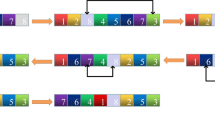Abstract
Digital images are increasingly transmitted over non-secure channels such as Internet, therefore image authentication techniques have recently gained great attention due to their importance for a large number of multimedia applications. To protect the authenticity of images, several approaches have been proposed. These approaches include conventional cryptography, semi-fragile watermarking and digital signatures. In this paper, we propose two techniques of the same type based on what we call characteristic data digest. Both techniques can blindly detect and localize malicious tampering, while maintaining reasonable tolerance to conventional content-preserving manipulations. The characteristic data is derived from the relative difference between each pair of selected DCT coefficient, AC for one technique and DC for another technique, in a central block and its counterpart estimated by the center block and its adjacent blocks. In order to maintain the relative difference relationship when the image undergoes legitimate processing, we make a pre-compensation for the coefficients. Experimental results show that our techniques are significantly superior to semi-fragile techniques under the condition of the same image fidelity, especially in tolerance range of legitimate processing, and/or the ability to detect and localize the tampered area. Due to the simplicity of the algorithms, our techniques can be used in video frame authentication, and even other digital media. In addition, this kind of proposed techniques can be extended to use other characteristic data, such as high-level moment, statistical data of images, and so on.


















Similar content being viewed by others
References
Andres F (2001) Multimedia and security. IEEE Trans Multimed 8(4):20–21
Battiato S, Maria G, Messina F, Puglisi G (2002) Robust Image Alignment for Tampering Detection. IEEE Trans Inf Forensics Secur 7(4):1105–1117
Bennett W (1970) Introduction to Signal Transmission (Electrical & Electronic Engineering), 1st edn. McGraw-Hill Inc., New York, pp 100–110
Cao H, Kot AC (2013) On Establishing Edge Adaptive Grid for Bi-level Image Data Hiding. IEEE Trans Inf Forensics Secur 8(9):1508–1518
CASIA (2017) Available: http://forensics.idealtest.org/ Accessed 28 Dec 2017
Dittmann J, Steinmetz A, Steinmetz R (1999) Content-based digital signature for motion pictures authentication and content-fragile watermarking. In: Proc. IEEE Int. Conf. Multimedia Computing and Systems, vol II. IEEE Computer Society, New York, pp 209–213
Fei C, Kundur D, Kwong RH (2006) Analysis and design of secure watermark-based authentication systems. IEEE Trans Inf Forensics Secur 1(1):43–55
Feng W, Liu ZQ (2008) Region-Level Image Authentication Using Bayesian Structural Content Abstraction. IEEE Trans Image Process 17(12):2413–2424
Gonzales CA, Allman L, Mccarthy T (1990) DCT coding for motion video storage using adaptive arithmetic coding. Signal Process Image Commun 2(2):145–154
Guzman AM, Goryawala M, Wang J, Adjouadi M (2013) Thermal Imaging as a Biometrics Approach to Facial Signature Authentication. IEEE J Biomed Health Informatics 17(1):214–222
Haouzia A, Noumeir R (2008) Methods for image authentication: a survey. Multimed Tool Appl 1(39):1–46
Lampson B, Rivest R (1997) Cryptography and information security group research project: a simple distributed security infrastructure. Technical report, MIT. http://www.people.csail.mit.edu/rivest/pubs.html#RL96
Lin C-Y, Chang S-F (2001) A robust image authentication method distinguishing JPEG compression from malicious manipulation. IEEE Trans Circuits Syst Video Technol 11(2):153–168
Lin C, Chang S (2010) Semi-fragile watermarking for authenticating JPEG visual content. Proc. SPIE 3971, Security and Watermarking of Multimedia Contents II, (9 May 2000). https://doi.org/10.1117/12.384968
Lin ET, Podilchun CI, Delp EJ (2000) Detection of image alterations using semi-fragile watermarks. Proc. SPIE 3971, Security and Watermarking of Multimedia Contents II, (9 May 2000). https://doi.org/10.1117/12.384969
Liu S, Lu M, Liu G, Pan Z (2017) A novel distance metric: generalized relative entropy. Entropy 19(6):269. https://doi.org/10.3390/e19060269
Liu S, Pan Z, Song H (2017) Digital image watermarking method based on DCT and fractal encoding. IET Image Process 11(10):815–821
Liu S, Fu W, He L, Zhou J, Ma M (2017) Distribution of primary additional errors in fractal encoding method. Multimed Tool Appl 76(4):5787–5802
Monga V, Evans BL (2006) Perceptual Image Hashing Via Feature Points: Performance Evaluation and Tradeoffs. IEEE Trans Image Process 15(11):3452–3465
Nender W, Gruhl D, Morimoto N, Lu A (1996) Techniques for data hiding. IBM Syst J 3:131–136
Rey C, Dugelay JL (2000) Blind detection of malicious alterations on still images using robust watermarks. Proc. IEE Secure Images and Image Authentication Colloquium, London, pp 7/1–7/6
Schneider M, Chang S-F (1996) A robust content based digital signature for image authentication. Proc IEEE Int Conf on Image Processing 3:227–230
Tagliasacchi M, Valenzise G, Tubaro S (2009) Hash-Based Identification of Sparse Image Tampering. IEEE Trans Image Process 18(11):2491–2504
Toyokawa K, Morimoto N, Tonegawa S, Kamijo K, Koide A (2000) Secure digital photograph handling with watermarking technique in insurance claim process. Proc SPIE 3971:438–445
Tse D, Viswanath P (2005) Fundamentals of wireless communication, 1st edn. Cambridge University Press, Cambridge, pp 203–210
Wu CW (2012) On the design of content-based multimedia authentication systems. IEEE Trans Multimed 4(3):385–393
Yu GW, Lu CS, Liao HYM (2001) Mean quantization-based fragile watermarking for image authentication. Opt Eng 40(7):1396–1408
Yuan H, Zhang XP (2006) Multi-scale Fragile Watermarking Based on the Gaussian Mixture Model. IEEE Trans Image Process 15(10):3189–3200
Yuan L, Ran Q, Zhao T (2017) Image authentication based on double-image encryption and partial phase decryption in nonseparable fractional Fourier domain. Opt Laser Technol 88:111–120
Zhu BB, Swanson MD, Tewfik AH (2004) When seeing isn't believing [multimedia authentication technologies]. IEEE Signal Process Mag 21(2):40–49
Zhu BB, Swanson MD, Tewfik AH (2004) When seeing isn’t believing. IEEE Signal Processing Mag 21(2):40–49
Acknowledgements
This work was supported by applied basic research plan of Wuhan Science and Technology Bureau with Grant No. 2017010201010105 in China, and Shenzhen Science and Technology Innovation Committee with Grant No. JCYJ20170306170559215 in China.
Author information
Authors and Affiliations
Corresponding author
Rights and permissions
About this article
Cite this article
Ding, W., Xie, Y. & Wang, Y. Image authentication and tamper localization based on relative difference between DCT coefficient and its estimated value. Multimed Tools Appl 78, 5305–5328 (2019). https://doi.org/10.1007/s11042-018-5732-z
Received:
Revised:
Accepted:
Published:
Issue Date:
DOI: https://doi.org/10.1007/s11042-018-5732-z




